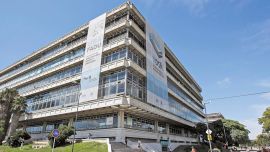Argentina’s poverty rate fell to 25.7 percent in the second half of 2017, the INDEC national statistics bureau announced this week.
The number of those falling below the poverty line who are considered “destitute,” or who live in extreme poverty, has fallen to 4.8 percent, INDEC added, compared to 6.2 percent in the first half of the year.
The new poverty level is a considerable drop from the 28.6 percent level registered by INDEC in the first half of 2017. In the latter half of 2016, the bureau recorded a figure of 30.3 percent.
The updated poverty figure shows that some 10.7 million people are still considered to be living below the poverty line.
President Mauricio Macri, speaking at a press conference at the Olivos presidential residence this afternoon, hailed the figures as proof his government was tackling poverty, though he said there was still work to do.
“This drop makes us happy, but we know that it is still lacking. There are still Argentines who have dreams to be fulfilled,” he said at an event in the presidential residence of Olivos, on the outskirts of Buenos Aires.
“It is news that gives us hope for the future, because it confirms that we are on the right track,” he added, saying the figures showed that “2.7 million people have managed to escape poverty” since his administration took office.
SCEPTICISM
The government’s celebrations were met with scepticism from some sectors, including the Universidad Católica’s Observatory on Social Debt, whose director Agustín Salvia warned against optimism given that some of the most precarious sectors of society were still in a dire situation. Salvia also questioned INDEC’s methodology, noting that the formula was developed in 2004 and 2005, lowering the relative weight of public services, which suffered important hikes and have an outsized effect on poorer households.
Other critics argued that the current poverty level should not be considered entirely accurate, as it was recorded before further rises in utility rates were witnessed in the first few months of this year.
In addition, consumer gas prices in Argentina will rise 30 to 40 percent from April, the Energy Ministry confirmed earlier on Wednesday.
Other critics have observed that the measurement to measure poverty – the socalled “basket of goods” – is markedly different to figures used by Argentina’s regional neighbours.
Macri said that reducing poverty was his “main concern and priority,” though he argued that the problem would not be solved solely by offering government handouts.
”Social plans are necessary,” he said, “but they are not enough to create a better future.”
REGIONAL BREAKDOWN
According to INDEC’s latest figures, the northeast is the poorest region of the country, with a poverty rate of 33.2 percent of the population, led by Corrientes (36.9 percent and Gran Resistencia 39.2 percent). The destitution rate there stood at 5.8percent, also the highest in the country.
The greatest number of poor people, though, inhabit Greater Buenos Aires — which includes the City and Buenos Aires province — the most populous region in the country. There, 14.9 million people were considered poor (25.5 percent) and 815,000 live in extreme poverty (5.5 percent).
In Patagonia, the region with the lowest population density, the poverty rate stood at 18.9 percent, making it the best in the country in that measure. At 2.2 percent, it was also the region with the lowest level of extreme poverty.
Looking at major urban centres, Córdoba recorded a poverty rate of 36.1 percent, Rosario clocked in at 19.8 percent, and Mendoza at 26.4 percent. The City of Buenos Aires, though was the big outlier, being the only urban centre with a singledigit poverty rate, at 9 percent, compared with 29.5 percent for Buenos Aires province.
The trend was positive for all six regions (Greater Buenos Aires, Cuyo, Northeast, Northwest, Pampas, and Patagonia), as the second semester of 2017 showed declines over the previous period. The Greater Buenos Aires region saw a 3.3 percentage-point decrease, the largest decrease, giving some relief to Governor María Eugenia Vidal.
INDEC also posted figures indicating that economic activity in Argentina rose 4.1 percent in January, compared with the same month in 2017.























Comments